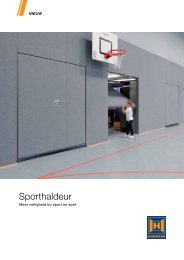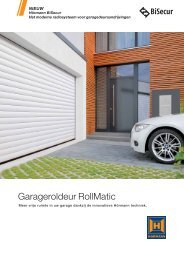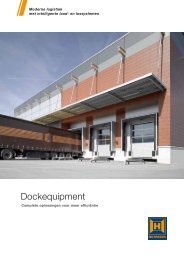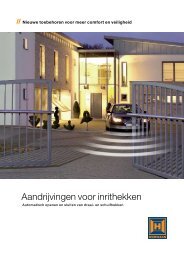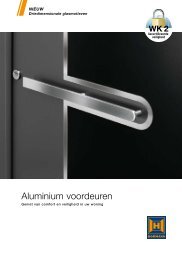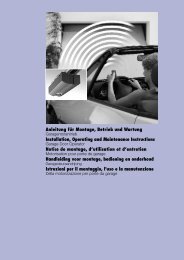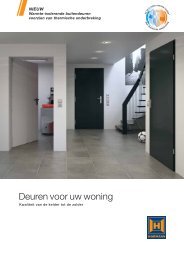2 - Hormann
2 - Hormann
2 - Hormann
Create successful ePaper yourself
Turn your PDF publications into a flip-book with our unique Google optimized e-Paper software.
3.1.3 Preferred range<br />
If an A/B dimension combination is selected from the<br />
grey section (see Figure 1 ), you can assume that the<br />
operational forces are maintained in accordance with<br />
DIN EN 12453, if the installation instructions and<br />
following conditions are observed:<br />
- The gate's centre of gravity must be in the middle of<br />
the gate (maximum permissible deviation ± 20%).<br />
- The DP2 sound-absorbing seal (item no. 436 304) is<br />
installed on the closing edge.<br />
- The operator is programmed for a slow speed (see<br />
Chapter 4.5.2).<br />
- The reversing limit at 50 mm opening width is monitored<br />
over the entire length of the main closing edge and<br />
maintained (see Chapter 4.7).<br />
3.1.4 Fastening the operator<br />
When installing the hinged gate operator, pay attention<br />
that it is installed horizontally, stably, and securely on<br />
both the wall post/post as well as on the gate leaf. Also<br />
use other suitable connecting elements, if necessary.<br />
Unsuitable connecting elements will not be able to<br />
withstand the forces caused by opening and closing.<br />
Note<br />
For hinged gates with lifting hinges (up to max. 6°), an<br />
accessory set* (see Figure 3.1b ) is required that must be<br />
ordered separately. This set is installed as shown in<br />
Figure 3.2 .<br />
Note<br />
Always cover the operator and control before drilling, since<br />
drilling dust and shavings can lead to malfunctions.<br />
3.2 Installing the operator control<br />
The control housing must be installed as shown in<br />
Figure 3.6 . Pay attention that the control is installed<br />
vertically with the cable fixings towards the bottom. The<br />
length of the connecting cable between the operator<br />
and control may be max. 10 m.<br />
3.3 Electrical connection<br />
54<br />
ENGLISH<br />
CAUTION<br />
The following points apply to all work<br />
involving electric:<br />
- Electrical connections may only be made by a<br />
qualified electrician!<br />
- The on-site electrical installation must comply<br />
with the respective safety regulations!<br />
-All the cables must be inserted into the control<br />
from underneath and be free from distortion.<br />
- Before performing any work on the gate system,<br />
always disconnect the operator from the power<br />
supply.<br />
- External voltage at any of the control system’s<br />
connecting terminals will completely destroy the<br />
electronics!<br />
* Accessory, not part of the standard equipment!<br />
-To avoid malfunctions, ensure that the operator<br />
cables are laid in an installation system separate<br />
to the mains supply line!<br />
- Cables laid in the ground must always be of the<br />
NYY type (underground cable, max. Ø 12 mm)<br />
(see Figure 2 ).<br />
- If using underground cables as an extension, the<br />
connection for the operator lines must be in a<br />
splash-proof junction box (IP65).<br />
3.4 Connecting standard components<br />
Mains connection is made directly at the plug terminal<br />
to the transformer via the NYY underground cable (see<br />
Figure 3.7 ).<br />
3.4.1 Connecting the operator for a single-leaf gate<br />
system<br />
Install the operator cables in the plug on leaf A (Flügel A)<br />
as shown in Figure 4.2 .<br />
3.4.2 Connecting the operator for a double-leaf gate<br />
system without a threshold (see Figure 4.3a )<br />
If the leaf sizes are different, the smaller leaf is the traffic<br />
leaf or leaf A.<br />
3.4.3 Connecting the operator for a double-leaf gate<br />
system with a threshold (see Figure 4.3b )<br />
In gates with a threshold, the first leaf that opens is the<br />
traffic leaf or leaf A (Flügel A). The operator cable for leaf<br />
B (Flügel B) is connected to plug B as shown in Figure<br />
4.3 .<br />
3.4.4 Determining the end-of-travel position detection<br />
See Figure 4.4a for the limit switch or Figure 4.4b for<br />
the limit stop (deactivate limit switch).<br />
3.5 Connecting additional components/accessories<br />
Note<br />
Loading of the operator by all accessories: max. 100 mA.<br />
3.5.1 Connecting an external radio receiver*<br />
(see Figure 4.5 )<br />
The wires of the radio receiver (ext. Funk) should be<br />
connected as follows:<br />
- GN to terminal 20 (0 V)<br />
- WH to terminal 21 (channel 1 signal)<br />
- BN to terminal 5 (+24 V)<br />
- YE to terminal 23 (channel 2 signal for the traffic leaf);<br />
only with a 2-channel receiver.<br />
Note<br />
The aerial wire of external radio receivers should not come<br />
into contact with metal objects (nails, bracing, etc.). The<br />
best alignment to achieve an optimum range must be<br />
established by trial and error. When used at the same time,<br />
GSM 900 mobile phones can affect the range of the radio<br />
remote control.<br />
08.2007 TR10A028-A RE



